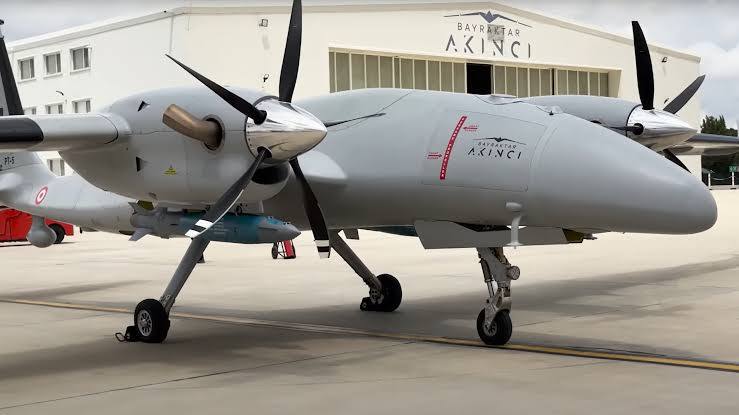Bünyamin Tekin
Iranian President Ebrahim Raisi along with Foreign Minister Hossein Amir-Abdollahian and other high-ranking officials was onboard a helicopter in the country’s remote northwest on Sunday.
Details of what happened next remain unclear, but poor weather along with an almost half-century-old helicopter prone to malfunction provide some likely explanations for what officials initially described as a hard landing that killed the 63-year-old Raisi, once seen as a likely successor to Iran’s supreme leader.
Despite having a lethal arsenal of suicide drones, Iran lacked the capability to dispatch drones that would help find the crash site. So they asked Turkey for help.
“Based on the request made by the Iranian authorities through our Ministry of Foreign Affairs, an Akıncı UAV and a night vision Cougar-type helicopter were assigned to participate in the search and rescue activities for the crashed helicopter of the President of Iran and his delegation,” the Turkish Defense Ministry announced on X.
The UAV patrolled the skies of northwest Iran near the Turkish border, scanning for potential evidence. It became the most tracked aircraft in the world, with over 2.5 million people following its movements online and watching the live stream of the drone’s operations. According to reports circulating on social media, the drone was on the job for more than seven hours.
Turkish Bayraktar AKINCI UAV’s 7-hour and 27-minute search & rescue operation that captured the world's attention. pic.twitter.com/wy7jHiMRAh
— Clash Report (@clashreport) May 20, 2024
The Turkish Bayraktar Akıncı drone detected a source of heat early on Monday, which eventually led to the wreckage of the helicopter carrying the Iranian president.
Iran plays down the claim that the Turkish drone Akıncı found the wreckage, claiming instead that it was drones Iran received from Armenia and equipped by Moscow.
Iran’s official news agency IRNA says that the coordinates shared by the Turkish drones were off by 7 km.
After helping Iran to find out President Raisi’s helicopter crash site, Turkish drone Bayraktar Akıncı draw the Turkish national symbol on the map 🇹🇷 pic.twitter.com/sLchrxqvyv
— Xavi Ruiz (@xruiztru) May 20, 2024
Following the completion of its designated mission, the Akıncı drew Turkey’s national symbol — a star and crescent — in the sky during its flight above eastern Turkey.
Military watchers on social media believe the drone has effectively come to represent Turkish pride. This sentiment was also visible in Turkish military bloggers posting comical memes on social media, glorifying their Akıncı drone and mocking Iran.
The Akıncı drone is produced by Baykar Savunma (Baykar Defense). Owned by President Recep Tayyip Erdoğan’s son-in-law Selçuk Bayraktar, the company has been manufacturing drones for years, but the company’s prestige truly took off thanks to its accomplishments amid Turkey’s involvement in conflicts in Syria, Libya and Azerbaijan.

One of their drones, the Baykar TB2 UAV, gained fame with its stunning combat performance in the Nagorno-Karabakh conflict of 2020. Azeri forces flying Turkish drones destroyed Armenian artillery, armor, bunkers and air defense systems, as seen in several videos posted online.
The TB2 was soon acquired by other countries and deployed to multiple war zones. The drones have since become poster heroes of Turkey’s drone manufacturing industry. More than 30 countries are known to have acquired the drone.
However, there is another side to this story that is often overlooked.
Turkish drones and war crimes in Horn of Africa
Twin airstrikes by Somalia’s military using Turkish drones killed 23 civilians, including 14 children, in March, rights watchdog Amnesty International said on May 7, calling for an investigation into possible “war crimes.”
The fragile Horn of Africa nation, which has battled an Islamist insurgency for over 16 years, has a history of defense cooperation with Turkey, hosting its largest overseas military base and training facility.
The alleged strikes on March 18 hit a farm near Bagdad village in the southern Lower Shabelle region, killing nearly two dozen people and injuring 17 others, mostly children, the rights group said.
Amnesty International investigators confirmed the use of Turkish-manufactured bombs and TB-2 drones in attacks that killed civilians, based on interviews and analysis of satellite imagery and weapon fragments. The rights group urged the Somali and Turkish governments to investigate these incidents as war crimes and end reckless attacks on civilians.

“The long-term implications of consistent drone use in the region are already apparent. While the use of drones is usually deemed safer for military personnel who no longer have to enter combat zones, the use of drones has led to an increase in civilian casualties,” Sarah Hunter, senior research and advocacy officer at the Global Centre for the Responsibility to Protect, told Turkish Minute, highlighting the broader implications of drone use in conflicts in the Horn of Africa.
“In Ethiopia, for example, during the Tigray war, the use of drones was linked to many mass casualty events in public spaces. [Their continual] use in Amhara and Oromia regions has caused multiple mass casualty events that heavily impacted civilians in civilian populated areas, and may amount to war crimes,” Hunter said.
30th November – USA: We tried to stop #Tigray Genocide, but we couldn't even stop #Turkey (who is also a #NATO Member) that was sending TB2 drones (Intellectual property of NATO) to target and bombard civilians.
– @MikeHammerUSA, Special Envoy to the Horn of #Africa at the… pic.twitter.com/P54JViitat
— Tigray Update (@TigrayUpdate) December 1, 2023
In 2022, The Washington Post confirmed that Ethiopia used a Turkish drone in a January attack that killed at least 59 civilians in a school in Tigray, with analysis identifying the weapon as a Turkish-made MAM-L bomb fitted to a Bayraktar TB-2 drone.
The attack was part of a series of drone strikes since September 2021 that have killed over 300 civilians, drawing criticism from international organizations for potential violations of international law.
“Unfortunately, the same goes for drone use in Somalia, where increasing use of drones has had a negative impact on civilian populations. Drones were responsible for the deaths of dozens of civilians across the country this year alone,” Hunter said.
Turkey’s export of armed drones significantly increased in 2021, with major sales to African countries contributing to a record level of defense exports.
“The use of drones, especially in civilian areas, exemplifies a growing trend of disregarding the laws of war and the flouting of international legal obligations to protect civilians in conflict at all costs,” Hunter said.
As a result of this disregard, “civilians are bearing the brunt of the conflicts they rarely had a part in creating, causing long-lasting grievances, displacement and devastation that are rarely addressed by their government, the arms suppliers, and the international community,” Hunter pointed out.
“One way for citizens of any state, such as Turkey, to support arms regulation is to advocate for the signing and ratification of relevant treaties. Turkey, for example, has signed but not ratified the Arms Trade Treaty [ATT], and is therefore not bound by its provisions to ensure that exported weapons are not used in gross human rights violations.”
The ATT forbids the transfer of conventional weapons if there is a substantial risk they will be used in serious violations of international human rights or humanitarian law, acts of genocide or crimes against humanity. It also prohibits transfers that would facilitate terrorist attacks or organized crime or violate UN arms embargoes. Additionally, the treaty mandates that arms exports must not adversely affect regional security, socioeconomic development or be diverted to unauthorized users.
“Civilians can urge their government to honor these commitments and ratify such treaties. Furthermore, they can push for stricter controls similar to those in Germany, where permission is required before exporting military equipment to ensure it is not used for committing atrocities. By demanding their government refrain from participating in civilian atrocities, citizens can make a significant impact,” according to Hunter.
